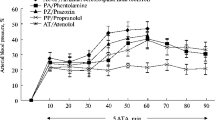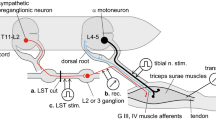Summary
In 72 cats anaesthetized with ether the postganglionic, motor branch of the sympathetic nerve innervating the Müller's muscle in the eyelid has been isolated. Electrical stimulation of this branch resulted in a selective retraction of the lids. Following a section of this nerve a pregnaglionic stimulation of the cervical sympathetic trunk was still capable of eliciting a mydriatic response and retraction of the nictitating membrane, it failed, however, to affect the opening of the eyelids.
From this nerve, functional single fibres or larger filaments containing several active efferent fibres have been prepared. Action potentials from these fibres were recorded after the anaesthesia had worn off, the animals being partially immobilised by d-tubocurarine and artificially respired. The effect of reserpine on the activity in such fibres was determined. The results were as follows:
-
1.
Reserpine in a dose of 1.0 mg/kg i.v. failed to show any inhibitory effect on motor sympathetic innervation within 2 hours. In some of the experiments reserpine gave rise to an initial increase in the discharges in the first 20 minutes.
-
2.
Following pretreatment with reserpine (1.0 mg/kg 24 h prior to the experiment s.c.) the activity in the postganglionic motor sympathetic branch was similar to that found in untreated controls.
-
3.
The reaction of the sympathetic motor innervation to activating stimuli such as pain, decrease in blood pressure and anoxia was the same in untreated animals and in those pretreated with reserpine (2 or 24 h prior to the experiment).
-
4.
Cocaine (5.0 mg/kg i.v.) caused a transient reversal of the reserpine ptosis and had no excitatory effect on the postganglionic activity of the motor sympathetic nerve.
-
5.
These results are in accordance with those obtained on the preganglionic cervical sympathetic trunk.
As shown by these experiments reserpine does not cause a specific deficiency in the innervation of Müller's muscle of the eye.
The results are in agreement with the assumption that the ptosis caused by reserpine is brought about mainly by an interruption of the sympathetic motor innervation at a peripheral site.
Zusammenfassung
An 72 Katzen wurde in Äthernarkose der zum Müllerschen Muskel des Augenlides führende postganglionäre, motorische Sympathicus-Ast isoliert. Dieses Bündel ergab bei elektrischer Reizung eine selektive Lidspaltenerweiterung. Nach Durchtrennung dieses Nerven führte eine präganglionäre Halssympathicus-Reizung noch zur Mydriasis und Nickhaut-Retraktion, die Wirkung auf die Lidspalte war jedoch verschwunden. Dieser Nerv wurde aufgeteilt und funktionelle Einzelfaserpräparate bzw. größere Filamente mit mehreren aktiven efferenten Fasern hergestellt. Nach Abklingen der Narkose wurden diese Fasern am wachen durch d-Tubocurarin teilimmobilisierten, künstlich beatmeten Tier abgeleitet und die Wirkung von Reserpin auf die Aktivität in diesen Fasern geprüft. Dabei ergab sich:
-
1.
Reserpin hatte in Dosen von 1,0 mg/kg i.v. in einem Zeitraum von 2 Std keine hemmende Wirkung auf die motorisch-sympathische Innervation. In einem Teil der Versuche wurde eine initiale, etwa 20 min andauernde, Steigerung der Entladungstätigkeit durch Reserpin ausgelöst.
-
2.
Bei chronischer Vorbehandlung mit Reserpin (1,0 mg/kg 24 Std vorher s.c.) wurden grundsätzlich gleiche Aktivitäten im postganglionären motorischen Sympathicus-Ast beobachtet wie bei nichtvorbehandelten Tieren.
-
3.
Die Reaktivität der sympathisch-motorischen Innervation auf aktivierende Reize (Schmerz, Blutdruckabfall, Anoxie) war bei unbehandelten, akut und chronisch Reserpin-vorbehandelten Tieren gleich.
-
4.
Cocain (5,0 mg/kg i.v.), das die Reserpin-Ptosis vorübergehend aufhebt, hatte keine deutliche erregende Wirkung auf die postganglionäre Aktivität im motorischen Sympathicus.
-
5.
Die Befunde entsprechen denen am präganglionären Halssympathicus.
Die Versuche zeigen, daß Reserpin weder bei akuter noch bei chronischer Behandlung zu einem spezifischen Ausfall der motorischen Innervation des Müllerschen Muskels führt. Sie bestätigen die Vermutung, daß die Reserpin-Ptosis in erster Linie durch eine periphere Unterbrechung der sympathisch-motorischen Innervation zustande kommt.
Similar content being viewed by others
Literatur
Aceto, M. D., and L. S. Harris: Effect of various agents on reserpine-induced blepharoptosis. Toxicol. appl. Pharmacol. 7, 329–336 (1965).
Adrian, E. D., D. W. Bronk, and G. Phillips: Discharges in mammalian sympathetic nerves. J. Physiol. (Lond.) 74, 115–133 (1932).
Bein, H. J.: Effects of reserpine on the functional strata of the nervous system. In: Psychotropic Drugs, pp. 325–331. Ed. S. Garattini and V. Ghetti. Amsterdam: Elsevier 1957.
Bishop, G. H., and P. Heinbecker: A functional analysis of the cervical sympathetic nerve supply to the eye. Amer. J. Physiol. 100, 519–532 (1932).
Boura, A. L. A., F. C. Copp, W. C. Duncombe, A. F. Green, and A. McCoubrey: The selective accumulation of bretylium in sympathetic ganglia and their postganglionic nerves. Brit. J. Pharmacol. 15, 265–270 (1960).
Brodie, B. B., S. Spector, and P. A. Shore: Interactions of drugs with norepinephrine in the brain. Pharmacol. Rev. 11, 548–564 (1959).
Bronk, D. W., L. K. Ferguson, R. Margaria, and D. Y. Solandt: The activity of the cardiac sympathetic centres. Amer. J. Physiol. 117, 237–249 (1936).
Burlet, H. M. de: Anatomische Bemerkungen zur vorausgehenden Arbeit von de Kleijn u. Socin. Pflügers Arch. ges. Physiol. 160, 416–422 (1915).
Canary, T. J., M. Schaaf, J. B. Duffy, and L. H. Kyle: Effects of oral and intramuscular administration of reserpine in thyreotoxicosis. New Engl. J. Med. 257, 435–442 (1957).
Carlsson, A.: Pharmacology of the sympathetic nervous system. In: Antihypertensive Therapy, pp. 5–14. Ed. F. Gross. Berlin-Heidelberg-New York: Springer 1966.
Chen, G.: Antidepressives, analeptics and appetite suppressants. In: Evaluation of drug activities. Pharmacometrics, Vol. 1, pp. 239–260. Ed. D. R. Laurence and A. L. Bacharach. London: Academic Press 1964.
——, and B. Bohner: The anti-reserpine effects of certain centrally acting agents. J. Pharmacol. exp. Ther. 131, 179–184 (1961).
Chessin, M., E. R. Kramer, and C. C. Scott: Modifications of the pharmacology of reserpine and serotonin by iproniazid. J. Pharmacol. exp. Ther. 119, 453–460 (1957).
Costa, E., R. Kuntzman, G. L. Gessa, and B. B. Brodie: Structural requirements for bretylium and guanethidine-like activity, Life Sci. 3, 75–80 (1962).
——, and G. R. Pscheidt: Correlations between active eyelid closure and depletion of brain biogenic amines by reserpine. Proc. Soc. exp. Biol. (N. Y.) 106, 693–696 (1961).
Crombie, A. L., and A. A. H. Lawson: Long-term trial of local guanethidine in treatment of eye signs of thyroid dysfunction and idiopathic lid retraction. Brit. med. J. 4, 592–595 (1967).
Dasgupta, S. R., and T. J. Haley: Intraventricular administration of reserpine and its metabolites to conscious cats. Brit. J. Pharmacol. 12, 529–531 (1957).
Dontas, A. S., and M. Nickerson: Central and peripheral components of the action of ganglionic blocking agents. J. Pharmacol. exp. Ther. 120, 147–159 (1957).
Eccles, J. C.: The action potential of the superior cervical ganglion. J. Physiol. (Lond.) 85, 179–206 (1935).
Fielden, R., and A. L. Green: Validy of ptosis as a measure of the central depressant action of reserpine. J. Pharm. Pharmacol. 17, 185–187 (1965a).
—— —— The effects of some arakylguanidines in mice. Brit. J. Pharmacol. 24, 408–417 (1965b).
Fukuda, M.: Studies on the nerve endings in the extrinsic eye muscles of the rabbit. Jap. J. Ophthal. 2, 93–101 (1958).
Haley, T. J., and S. R. Dasgupta: Pharmacological effects following intracerebral and intravenous reserpine in conscious mice. Arch. int. Pharmacodyn. 120, 12–16 (1959).
Iggo, A., and M. Vogt: The effect of reserpine on the electrical activity in preganglionic sympathetic fibres. J. Physiol. (Lond.) 147, 14–15 P (1959).
—— —— Preganglionic sympathetic activity in normal and in reserpine-treated cats. J. Physiol. (Lond.) 150, 114–133 (1960).
Kleijn, A. de: Zur Kenntnis des Verlaufs der postganglionären Sympathicusbahnen für Pupillenerweiterung, Lidspaltenöffnung und Retraktion der Nickhaut bei der Katze. Zbl. Physiol. 28, 4–7 (1912).
Kleijn, A., u. C. Socin: Zur näheren Kenntnis des Verlaufs der postganglionären Sympathicusbahnen für Pupillenerweiterung, Lidspaltenöffnung und Nickhautretraktion bei der Katze. Pflügers Arch. ges. Physiol. 160, 407–415 (1915).
Kuga, T., u. W. D. Erdmann: Über die Wirkung von Paraoxon auf die elektrische Aktivität des efferenten Halssympathicus und den Blutdruck der Ratte. Naunyn-Schmiedebergs Arch. Pharmak. exp. Path. 258, 457–470 (1967).
Kukovetz, W. R., u. F. Lembeck: Untersuchungen über die adrenalinpotenzierende Wirkung von Cocain und Denervierung. Naunyn-Schmiedebergs Arch. exp. Path. Pharmak. 242, 467–479 (1962).
Randall, L. O., and R. E. Bagdon: Pharmacology of iproniazid and other amine oxidase inhibitors. Ann. N. Y. Acad. Sci. 80, 626–642 (1959).
Ri, H. dal, u. G. Schmidt: Die Aufzeichnung schneller biologischer Vorgänge auf elektromechanischen Direktschreibern durch Frequenztransformation. Z. Biol. 115, 30–40 (1965).
Rubin, B., and J. C. Burke: Mouse ptosis bioassay of Ranwolfia serpentina for reserpine-like activity. Fed. Proc. 13, 400–401 (1954).
——, and J. C. Burke: Bioassay of rauwolfia roots and alkaloids. J. Pharmacol. exp. Ther. 120, 125–136 (1957).
Schaeppi, U.: Dis. Bem. Tag. Dtsch. Pharmakol. Ges. Basel. Naunyn-Schmiedebergs Arch. exp. Path. Pharmak. 238, 43 (1960).
Schmidt, G., u. P. Meisse: Zentrale Wirkungen von Cocainhomologen und ihre Beeinflußbarkeit durch Reserpin oder Adrenolytica. Naunyn-Schmiedebergs Arch. exp. Path. Pharmak. 243, 148–161 (1962).
—— u. L. Lendle: Der Einfluß hoher Nicotindosen auf die elektrische Aktivität im efferenten N. vagus und N. phrenicus der Ratte. Naunyn-Schmiedebergs Arch. exp. Path. Pharmak. 248, 464–482 (1964).
Sneddon, P., and P. Turner: Adrenergic blockade and the eye signs of thyreotoxicosis. Lancet 1966II, 525–527.
—— —— The effect of local guanethidineon the palpebral fissure and the pupil in the thyreotoxicosis and its interaction with sympathic amines. J. Physiol. (Lond.) 189, 20P-22P (1967).
Sulser, S.: Blocking of reserpine action by imipramine, a drug devoid of stimulatory effects in normal animals. Fed. Proc. 20, 321 (1961).
Sulser, F., J. S. Watts, and B. B. Brodie: On the mechanism of antidepressant action of imipramine-like drugs. Ann. N. Y. Acad. Sci. 96, 279–288 (1962).
Trabucchi, E.: Antagonists of reserpine eyelid ptosis. Newsletter Ist. farmacol. Milano 2, 4 (1960).
Waldstein, S. S., G. H. West, Jr., W. Y. Lee, and D. Bronsky: Guanethidine in hyperthyroidism. J. Amer. med. Ass. 189, 609–612 (1964).
Wilson, S. P., and R. Tislow: Differential antagonism of reserpine eyelid closure by imipramine and amphetamine. Proc. Soc. exp. Biol. (N.Y.) 109, 847–848 (1962).
Author information
Authors and Affiliations
Additional information
Herrn Professor F. v. Brücke, Wien, zum 60. Geburtstag gewidmet.
Auszugsweise vorgetragen auf der 30. Tagung der Deutschen Pharmakologischen Gesellschaft in Kiel 1966, vgl. Schmidt, G., H. J. Küsel u. H. Dal Ri: Naunyn-Schmiedebergs Arch. Pharmak. exp. Path. 257, 59 (1967).
Rights and permissions
About this article
Cite this article
Schmidt, G., Küsel, H.J. & Dal Ri, H. Über die Wirkung von Reserpin auf die sympathisch-motorische Innervation des Auges. Naunyn-Schmiedebergs Arch. Pharmak. u. Exp. Path. 261, 75–88 (1968). https://doi.org/10.1007/BF00537869
Received:
Issue Date:
DOI: https://doi.org/10.1007/BF00537869




